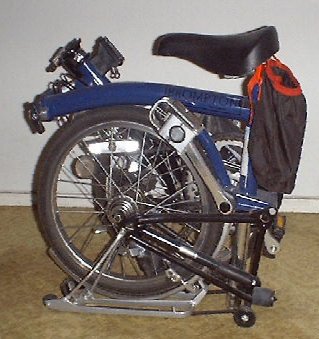A British classic, patented by Andrew Ritchie in 1979 and still going strong.

While the Brompton is practically unbeatable for its folding ability, and is great fun to ride around town, it is not really the ideal bike for longish tours, with its very upright riding position and terrible aerodynamics. Still, it gave me the incentive to venture much further afield in my recreational cycling, and discover a great deal more of the Dutch countryside than what is within a day’s ride of where I live.
The Brompton comprises 12.9 kg of remarkable engineering design, which folds down to the size of a large briefcase in a matter of moments, and yet rides like a “proper bicycle”. One test ride and a few demonstrations of folding and unfolding and I was convinced.
You can find pictures and all the technical stuff here, and there is also an excellent Brompton users’ mailing list and faq, so I’ll confine myself to my impressions of the bike after about two years’ use. Folding and unfolding is fast, and you soon learn the correct sequence. Despite the little wheels on the luggage rack, carrying the folded bike is awkward, and it’s well worth unfolding it for any but the shortest change of trains (some people fit in-line skate wheels instead of the little castors supplied, but this has the drawback that the folded bike rolls around in the train). On Dutch trains, you’re supposed to leave folding bikes in the area by the doors, which means either sitting next to the bike on a tip-up seat, or locking the folded bike to something solid so that you can go and sit in comfort elsewhere. I’m not sure that this is legal, but no-one has complained yet. I bought myself a light cable lock for this purpose, on the basis that there aren’t that many railway passengers who carry bolt-croppers, and anyone using them in the train might attract attention. British trains generally have a large rack for suitcases in the end of the seating area, where the Brompton fits nicely, and you can keep an eye on it.
The bike rides very nicely. The small (16″) wheels make the steering rather sensitive, but you soon get used to that, and the low rotating mass means good acceleration. Generally the feel is of something very light and manouverable. So far I’ve used it mainly for doing odd sections of Dutch long-distance cycle routes (lf-Routes), typically covering 60 or 70 km between two railway stations in a leisurely day. The first few times I had a sore bottom (disadvantage of being used to recumbents?) at the end of the ride, and I’m not convinced that the elastomer suspension has much effect for a rider as light as I. But my seat soon became hardened again…
Luggage is a bit of a problem if you don’t have the optional Brompton front pannier. With the elastics supplied, you can attach a smallish bag (eg a day-pack) to the top of the rear carrier, but it has to go right at the back to keep it clear of your heels, which tends to make the back wheel fold up when you get off and try to wheel the bike, especially over rough ground. You have to remember to push down a bit on the saddle. Also, I kept forgetting to unload before attempting to fold the bike… The front pannier is a much better solution, though not very aerodynamic. Watch out for the front light, though - the bottom of the bag can rub against the top of the reflector and make it work loose.
The Sturmey-Archer 5-speed covers a reasonably wide range, and consequently the intervals between gears are on the large side for my taste (on the flat, with no headwind, I want to be somewhere between 4th and 5th) but this is not a major problem. People in hillier areas sometimes fit Bromptons with front derailleurs, but this would be a trifle exaggerated in Holland.

